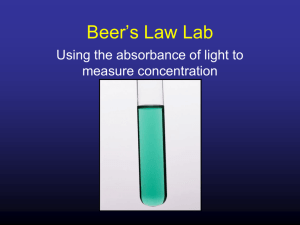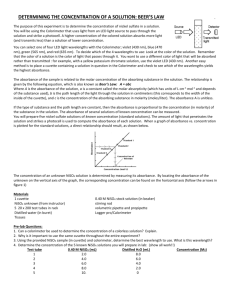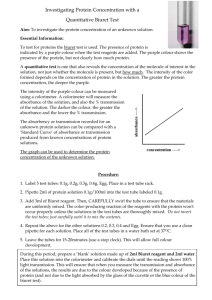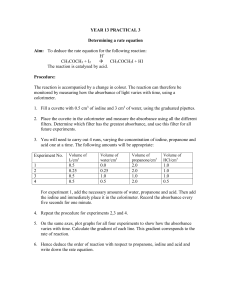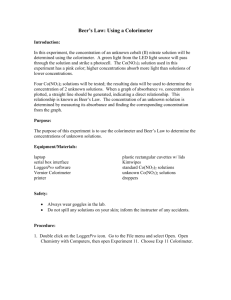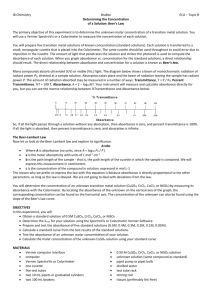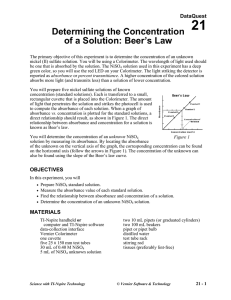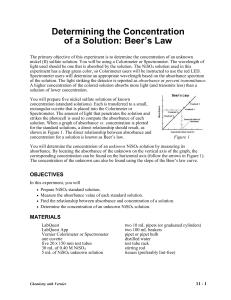determining the concentration of a solution: beer's
advertisement
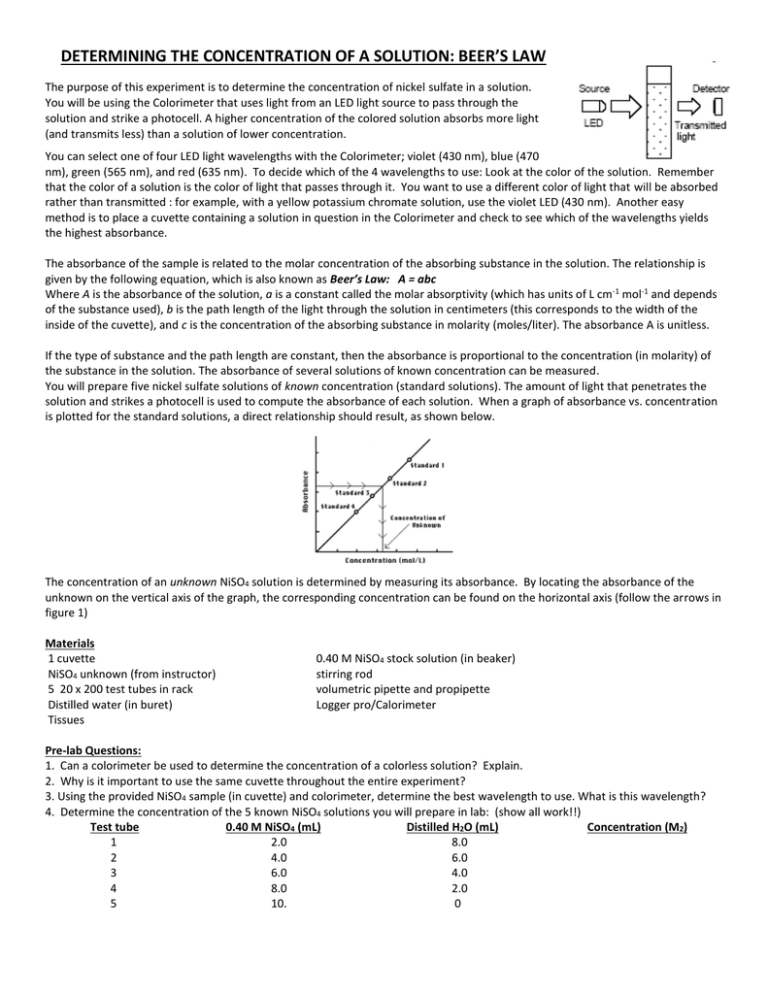
DETERMINING THE CONCENTRATION OF A SOLUTION: BEER’S LAW The purpose of this experiment is to determine the concentration of nickel sulfate in a solution. You will be using the Colorimeter that uses light from an LED light source to pass through the solution and strike a photocell. A higher concentration of the colored solution absorbs more light (and transmits less) than a solution of lower concentration. You can select one of four LED light wavelengths with the Colorimeter; violet (430 nm), blue (470 nm), green (565 nm), and red (635 nm). To decide which of the 4 wavelengths to use: Look at the color of the solution. Remember that the color of a solution is the color of light that passes through it. You want to use a different color of light that will be absorbed rather than transmitted : for example, with a yellow potassium chromate solution, use the violet LED (430 nm). Another easy method is to place a cuvette containing a solution in question in the Colorimeter and check to see which of the wavelengths yields the highest absorbance. The absorbance of the sample is related to the molar concentration of the absorbing substance in the solution. The relationship is given by the following equation, which is also known as Beer’s Law: A = abc Where A is the absorbance of the solution, a is a constant called the molar absorptivity (which has units of L cm-1 mol-1 and depends of the substance used), b is the path length of the light through the solution in centimeters (this corresponds to the width of the inside of the cuvette), and c is the concentration of the absorbing substance in molarity (moles/liter). The absorbance A is unitless. If the type of substance and the path length are constant, then the absorbance is proportional to the concentration (in molarity) of the substance in the solution. The absorbance of several solutions of known concentration can be measured. You will prepare five nickel sulfate solutions of known concentration (standard solutions). The amount of light that penetrates the solution and strikes a photocell is used to compute the absorbance of each solution. When a graph of absorbance vs. concentration is plotted for the standard solutions, a direct relationship should result, as shown below. The concentration of an unknown NiSO4 solution is determined by measuring its absorbance. By locating the absorbance of the unknown on the vertical axis of the graph, the corresponding concentration can be found on the horizontal axis (follow the arrows in figure 1) Materials 1 cuvette NiSO4 unknown (from instructor) 5 20 x 200 test tubes in rack Distilled water (in buret) Tissues 0.40 M NiSO4 stock solution (in beaker) stirring rod volumetric pipette and propipette Logger pro/Calorimeter Pre-lab Questions: 1. Can a colorimeter be used to determine the concentration of a colorless solution? Explain. 2. Why is it important to use the same cuvette throughout the entire experiment? 3. Using the provided NiSO4 sample (in cuvette) and colorimeter, determine the best wavelength to use. What is this wavelength? 4. Determine the concentration of the 5 known NiSO4 solutions you will prepare in lab: (show all work!!) Test tube 0.40 M NiSO4 (mL) Distilled H2O (mL) Concentration (M2) 1 2.0 8.0 2 4.0 6.0 3 6.0 4.0 4 8.0 2.0 5 10. 0 PROCEDURE Prepare solutions for Calibration—refer to the table in pre-lab 1. Using the pipette place ___ mL of the 0.40 M NiSO4 solution into the test tube. Add ____ distilled water (from buret) 2. Repeat step 1 prepare 10.0 mL in test tubes 2-4 3. Finally pour 10 mL of the 0.40 M NiSO4 into test tube 5. (No water is added.) 4. Thoroughly mix each solution with a stirring rod. 5. Double-click on the LoggerPro icon from the desktop. Open Chemistry/#11 Beer’s Law Calibrate the colorimeter at the desired wavelength with distilled water. 6. Select the appropriate wavelength (remember pre-lab!) 7. Prepare the cuvette a. fill a cuvette ¾ full with tap water, wipe outside of cuvette with tissue b. Insert the cuvette into the colorimeter with clear sides aligned with the arrow at the top. Close the colorimeter. 8. Press the CAL button to begin the calibration. Release the CAL button when the red light begins to flash. You should read 0.000 on the monitor. (This is the ONLY time the CAL button is used.) Collect data using your 5 solutions of known concentration. 9. The cuvette with water in the colorimeter should measure 0 absorbance with 0 concentration. 10. Click COLLECT, then KEEP. You will be prompted to enter the concentration. For water, enter 0. 11. Remove the cuvette and empty it. 12. Using the solution in test tube 1, rinse the cuvette twice with 1 mL portions, then fill it ¾ full. 13. Wipe outside of the cuvette with a tissue and place in device, close lid 14. Wait for absorbance to stabilize. Click KEEP AND enter the concentration 15. Discard cuvette contents, then repeat with the remaining solutions in test tubes 2 – 5. 16. When finished with test tube 5, click STOP. Note: To remove data with a known error: highlight cells / Edit / strike through data cells Prepare calibration curve 17. Get a straight line by clicking on linear – fit button. Measure the absorbance of your sample of unknown concentration. 18. Empty the cuvette and get unknown sample from instructor 17. Record the unknown sample number in data table. 18. Measure the absorbance (the reading is “live” so it is not necessary to click COLLECT) and record in the data table. 19. Remove the cuvette from the colorimeter. Analyzing the data 20. With the linear fit curve still displayed on your graph, choose Interpolate from the Analyze menu. A vertical cursor now appears on graph. The cursor’s concentration and absorbance coordinates are displayed in the floating box. Move the cursor along the regression line until the absorbance value is approximately the same as the absorbance value you recorded. The corresponding concentration value is the concentration of the unknown solution, mol/L – record this value on data table. 21. Insert a text box with all group members’ names. Call instructor to come over and save graph so it can be printed. Clean up 21. Empty test tubes and cuvette. Rinse test tubes and cuvette with distilled water. Do not rinse pipettes or remove your pipette bulb. 22. Staple you graph to your lab repor. Post-lab questions 1. Calculate the resulting concentration if a student diluted 5.0 mL of 0.40 M NiSO4 with 5.0 mL distilled water. (Show work!) 2. A student handles the cuvette that holds the unknown solution and leaves fingerprints (does not use a tissue to wipe off the fingerprints) in the path of the light beam. (a) Would the absorbance reading be too high, too low, or unaffected? Explain your answer (b) Would the resulting concentration of the unknown be too high, too low, or unaffected?


